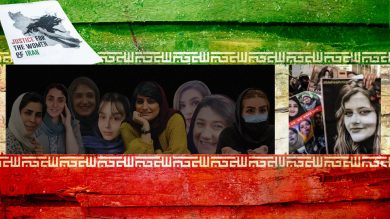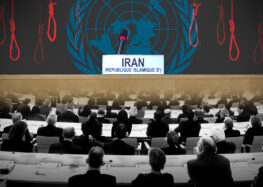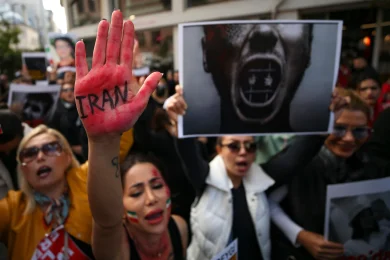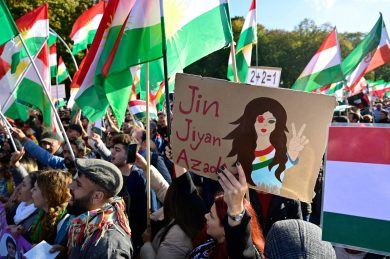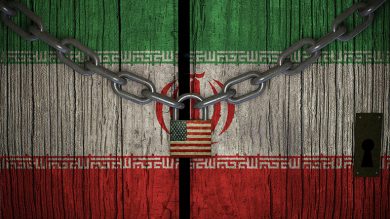The slogan “Women, Life, Freedom” has become the rallying cry of Iran’s most powerful and enduring protests, driven by decades of systemic repression and inequality. Sparked by the tragic death of Mahsa Amini in September 2022, after she was detained by the morality police for allegedly violating hijab laws, the movement has grown into a nationwide demand for justice, equality, and democracy. At the center of this revolution are Iran’s women, whose courage and leadership have inspired global solidarity and galvanized a broader struggle against authoritarianism.
This article explores how “Women, Life, Freedom” represents not only a feminist revolution but also a transformative moment in Iran’s history, uniting diverse communities in the fight for freedom and human dignity.
The Origins of “Women, Life, Freedom”
1. Kurdish Roots of the Slogan
• The slogan “Women, Life, Freedom” originates from the Kurdish feminist movement, where it symbolized the fight for equality and autonomy in a patriarchal society.
• Its adoption by Iranian protesters highlights the intersectionality of the movement, embracing the struggles of marginalized communities, including ethnic minorities.
2. Mahsa Amini: A Catalyst for Change
• Mahsa Amini, a 22-year-old Kurdish woman, became the face of the movement after her death in police custody sparked outrage.
• Her death symbolized the regime’s oppression of women and minorities, igniting protests across Iran and turning “Women, Life, Freedom” into a unifying cry.
The Feminist Foundation of the Revolution
1. Women at the Forefront
• Defying the Hijab Mandate: Women began removing and burning their hijabs in public, defying Iran’s mandatory dress code and reclaiming their bodily autonomy.
• Leading Protests: Women and girls have been at the forefront of demonstrations, challenging not only gender-based discrimination but also broader systemic repression.
2. Intersectional Struggles
• Ethnic and Religious Minorities: The movement has united diverse groups, including Kurds, Balochs, and Arabs, who face additional layers of discrimination.
• Economic Justice: Protesters also demand economic reforms, addressing unemployment, poverty, and corruption that disproportionately impact women.
3. A Broader Call for Human Rights
• While the movement began as a fight for women’s rights, it has evolved into a demand for fundamental freedoms, including freedom of speech, political representation, and social equality.
The Role of Women in Iran’s History of Resistance
1. The Constitutional Revolution (1905–1911)
• Women played a significant role in Iran’s early fight for modernization and political reform, advocating for education and women’s suffrage.
2. The Islamic Revolution (1979)
• Although many women supported the 1979 revolution hoping for greater rights, the establishment of the Islamic Republic led to stricter gender laws and a rollback of freedoms.
3. The Green Movement (2009)
• Women were prominent participants in the Green Movement protests, demanding political reforms and challenging election fraud.
4. The Current Revolution
• The “Women, Life, Freedom” movement is unprecedented in its scale, scope, and feminist foundation, signaling a turning point in Iran’s history.
Creative Resistance: Art, Music, and Culture
1. Protest Music and Poetry
• Songs like Shervin Hajipour’s “Baraye” have become anthems of the revolution, expressing the hopes and grievances of Iranian protesters.
• Poetry, a cornerstone of Persian culture, has been a tool for resistance, with contemporary poets writing about women’s rights and freedom.
2. Visual Arts and Graffiti
• Artists have used murals, graffiti, and digital illustrations to amplify the movement’s message, often at great personal risk.
• Images of women burning their hijabs and cutting their hair have become powerful symbols of defiance.
3. Social Media Activism
• Platforms like Instagram and Twitter have played a critical role in spreading the movement’s message globally, despite internet blackouts and censorship.
Challenges Facing the Movement
1. Brutal Repression
• The regime has responded to protests with violence, deploying the IRGC and Basij forces to crack down on demonstrators.
• Thousands of protesters, including many women, have been arrested, tortured, or killed.
2. Economic Hardships
• Sanctions and economic mismanagement have left many Iranians struggling to make ends meet, limiting their ability to sustain long-term protests.
3. Propaganda and Misinformation
• State media portrays protesters as foreign agents or terrorists, attempting to delegitimize the movement and divide public opinion.
Global Solidarity and Support
1. International Protests
• Demonstrations in solidarity with Iranian women have taken place in cities around the world, amplifying their voices and pressuring governments to act.
2. Sanctions and Diplomatic Pressure
• Targeted sanctions on Iranian officials and institutions responsible for human rights abuses signal international condemnation of the regime’s actions.
3. Support for Activists
• NGOs and human rights organizations have provided resources, legal aid, and safe havens for Iranian activists fleeing persecution.
The Broader Implications of “Women, Life, Freedom”
1. A Model for Feminist Resistance
• The movement has inspired feminist struggles worldwide, demonstrating the power of women-led resistance in challenging authoritarian regimes.
2. A Challenge to Authoritarianism
• By centering women’s rights, the movement strikes at the heart of the regime’s ideology, challenging its legitimacy and exposing its contradictions.
3. Hope for Future Generations
• The movement’s emphasis on freedom, equality, and human dignity offers a vision of a more inclusive and democratic Iran.
Conclusion
“Women, Life, Freedom” is more than a slogan; it is the heartbeat of a feminist revolution that transcends borders, cultures, and generations. Led by courageous women, supported by diverse communities, and amplified by global solidarity, the movement is reshaping Iran’s fight for freedom and inspiring the world. Despite immense challenges, the unwavering determination of Iranian women serves as a powerful reminder that the fight for justice and equality is universal—and that change is not only possible but inevitable.
Join Our Newsletter!
Stay informed with the latest updates, news, and ways to take action in the fight for justice and global security. Sign up now to get updates delivered straight to your inbox!

